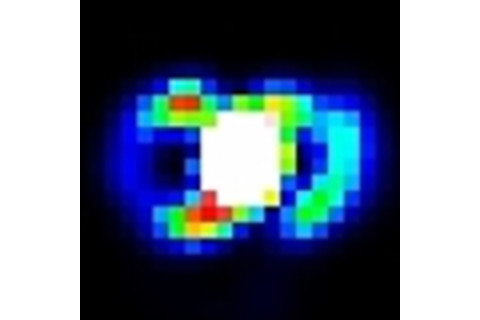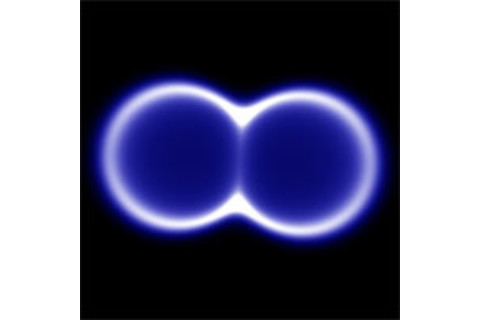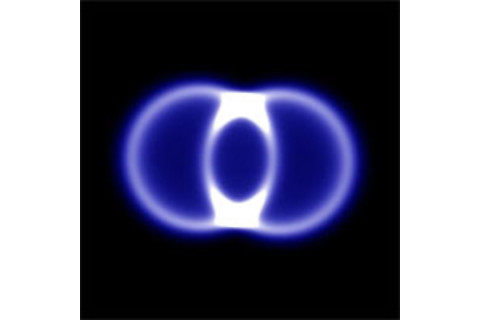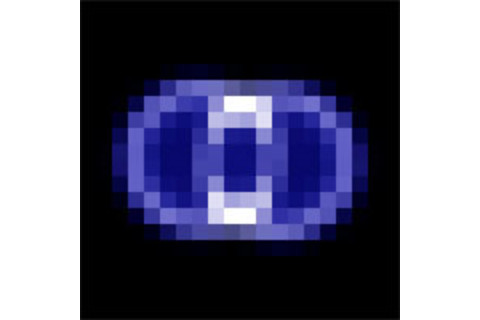I love it when scientists study an object I can truly sink my teeth into.

The image above is of RS Oph, a weird star some 5000 light years away. The star itself is in the center of those odd rings, and in fact it isn't an it, it's a they. It's actually a binary star, two stars orbiting each other. But neither star is normal. One, the primary (because it's brighter), is a red giant: an old star, maybe like the Sun will be in a few billion years. It's run out of hydrogen to fuse in its core, and as the core began to shrink it got hotter. The extra heat was dumped into the star's outer layers... and they responded as any gas does to extra heat: they expanded. So the star has puffed up. But all that extra surface area of the enlarged star means the heat is spread out over more real estate, so overall the star cools off. It turns red. Hence the name red giant. See? Weird. Now, the companion has roughly the same mass, but is far, far smaller. It also used to be a star like the Sun, though more massive. It too went through a red giant phase, but it lost its outer layers over thousands of years, ejecting them in a super-solar wind. All that's left now is the hot compressed core of the star, roughly the size of the Earth but with the mass of a full star. It's very hot, glowing white, but very small, so it's called a white dwarf. Also weird. But hang on! The white dwarf is so close to the red giant that it is actually drawing matter off the outside of the giant, gravitationally sucking it down like it has one of those curly crazy straws. The matter piles up on the white dwarf, and gets really squeezed due to the tremendous gravity of the dense star. If enough matter piles up, it can actually undergo catastrophic fusion, like a thermonuclear bomb. BANG! Matter is ejected at millions of kilometers per hour, and the system suddenly gets very, very bright. Weird? Actually, not really. This event, called a dwarf nova, happens all the time in the Galaxy. There are lots of binaries similar to RS Oph, and they undergo these nova events too. The last one for RS Oph happened in February 2006, and this dim star suddenly got bright enough to see with the unaided eye, which is pretty cool (it rained solidly here last year and I never got a chance to see it before it dimmed). However, RS Oph is not exactly like other binaries. The red giant is also blowing out a big, dense wind, and the white dwarf is sitting inside of it, essentially in the atmosphere of the red giant. When the dwarf nova occurred last year, the exploded material screamed out and slammed into the red giant wind, heating it to hundreds of millions of degrees. Within days, astronomers training their 'scopes on the system were greeted by a cigar-shaped expanding cloud of gas. Weird? Yeah, this time it is weird. Right away, that cigar-shaped nebula was a clue that something truly interesting was going on. If the explosion had happened in deep space, it would have been spherical, expanding equally in all directions. The cigar-shape meant that something else was happening. That something else was the red giant wind. Normally, a wind will expand in all directions, forming a sphere around the star (the Sun's solar wind does this, more or less). But the white dwarf and the red giant orbit around each other, so the red giant makes a big circle as it does so. The wind coming from it will prefer to blow out in the plane of that orbit. Think of it this way: if you take a bucket of water and spin it around you, the water that spills out will tend to fly away from you in the plane of the circle the bucket makes, right? Same thing here. So the wind is denser in the plane than toward the poles of the orbit. And it's in this wind that the white dwarf sits. So when it went bang, the matter flying outwards faced a tougher haul in the plane of the orbit, where the matter is denser, than along the poles, where the matter is less dense. The exploded material moved faster up and down, if you will, so it elongated into a cigar shape! Weirder and weirder. But now comes the weirdest part. 155 days after the explosion, a team of UK astronomers pointed Hubble at the system, and took that funny image at the top of this post. What's all that about? As the matter from the explosion continued to expand, it pushed against that old red giant wind. It also expanded sideways, since it's hot, inflating like a balloon. Eventually, after a few months, it blew two huge bubbles into the relic wind, two lobes of matter. The lobes are really like shells, or soap bubbles: thin shells of matter compressed by the expanding hot gas inside. We can model very easily what something like this would look like from the side:

Mmmmm, peanut. Actually, it's a nephroid
, a type of epicycloid
. And it looks a lot like a soap bubble! Now, we also know that the lobes of RS Oph are tilted to us by about 40 degrees, so we can model that too:

Hmmm, looking familiar. But the actually Hubble image of RS Oph can just barely resolve the nebula, so let's fuzz out the model to represent how well Hubble would see it:

Aha! Let's see them side-by-side, model on the left and the Hubble image on the right:


Cool, huh? It's a match! Looking at that, it's safe to say we have a pretty good grasp of what's going on here. Let me repeat that: we get this object. It's 5000 light years away, it's a binary, it's two old stars, one puffy and bloated, the other tiny and compressed, and one is eating the other while the other blows off a wind, and the tiny one periodically explodes, and forms a peanut-shaped soap bubbly nephroidal shell, which we can observe and model simply using undergrad-level math. And with all that, we can see we're pretty close to spot on with the models! Ah, science. It works. Now, as a postscript, I'm kicking myself. When I was in grad school I observed Supernova 1987A
with Hubble, and it too had this double-lobe thingy going on. I spent months modeling it using the exact same technique these astronomers did on RS Oph. I knew all about those peanut-shaped nephroids (which is why I was able to tell you about them), as well as shells and trying to match up the models and images. In other words, had I stayed on top of this event with RS Oph, I could have predicted the image would look like this. Nuts. Bonus points to the first person who figures out the title to this post.













